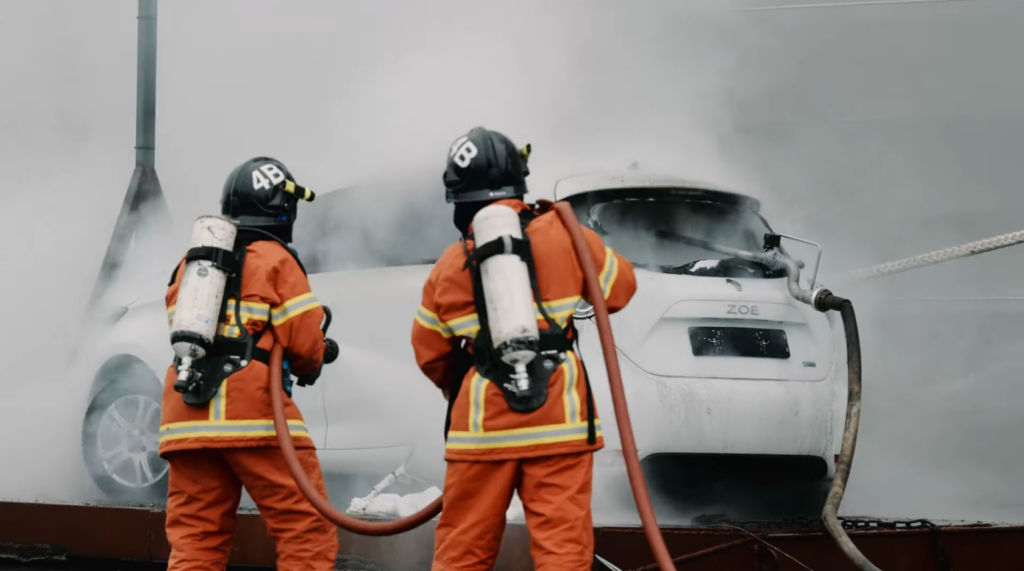Extinguishing lithium battery fires

(Battery Briner image)
Our battery show report in this issue contains stories on various materials engineered to prevent a thermal runaway in a cell in a lithium-ion pack from spreading and cause a major fire (writes Peter Donaldson).
Prevention is better than cure because, rare though they are, thermal runaways in EV lithium-ion batteries contain all four elements of the ‘fire tetrahedron’ – heat, oxygen, fuel and a chemical reaction – making them notoriously hard to extinguish. Putting them out is far from impossible, however.
Effective extinguishing agents for lithium-ion battery fires are an active area of r&d, and exploit many materials, usually combined with water. Several of these have come to light recently.
One of them is brine, which is water with a salt such as sodium chloride dissolved in it in a concentration between 5% and the saturation point of about 26%. While the salt increases the specific heat capacity of the water slightly, it also brings the solution’s freezing point down as low as -21 ºC, depending on the concentration, and increases its heat transfer capacity.
Chilled brine can therefore cool a battery very rapidly, absorb large amounts of heat and – because it is an electrolyte – rapidly discharge the battery. Small amounts of chlorine are released from the salt through electrolysis.
Battery Briner, a spin-off from Faeroese maritime support and transport company Skansi Offshore, demonstrated a system for car ferries early this year. In a dockside demonstration, firefighters used a system fitted in the Norruna ferry to pump brine at -19 ºC and 250 litres per minute into a Renault Zoe (on the dock) in which a thermal runaway had been induced. The resulting fire was extinguished within an hour.
Another approach is Hazard Control Technologies’ F500 Encapsulator Agent (EA). This is mixed with water and is designed to work by separating fuel from oxygen, rapidly absorbing heat, and interrupting the action of free radicals that would otherwise promote chemical chain reactions.
The encapsulant molecule has a ‘head’ that is attracted to water and a ‘tail’ that repels it. When mixed with water, the molecules orientate themselves with tails inward and heads outward, forming spherical micelle structures. Sprayed from a nozzle, these structures form EA droplets with a skin of water-repelling tails; each droplet contains millions of micelles.
The effect is to reduce the surface tension of water, making droplets smaller and creating more surface area to absorb heat more quickly and better penetrate the pores of solid material. The company recommends a solution of 3% EA in water for lithium battery fires.
Another promising agent is aqueous vermiculite dispersion (AVD) from AVD Fire. Vermiculite is a naturally occurring, environmentally friendly group of hydrated laminar aluminium-iron-magnesium silicates consisting of thin, flat flakes containing microscopic layers of water. AVD Fire uses a chemical exfoliation process to create microscopic individual vermiculite platelets that freely suspend themselves in water, forming an aqueous dispersion.
When sprayed onto a burning battery as a fine mist from standard firefighting equipment, the water instantly cools the battery while the vermiculite platelets encapsulate the fuel source, creating an oxygen barrier. It also insulates the cells, preventing further propagation of the thermal runaway.
A fourth example is Lion-X from Packaging and Crating Technologies, which also makes fire-retardant inked papers for wrapping battery cells, and Fireproof Solutions. Lion-X is described as a pre-mixed, water-based agent that forms a low-expansion foam from an aspirating nozzle.
The developers say the agent is compatible with portable as well as wheeled extinguishers, and can also be piped directly into EV battery packs without foaming. They also claim it can quench lithium-ion fires burning at more than 1600 ºF (870 ºC), typically within 30 seconds.
Options for firefighters are expanding, and the EV industry would do well to consider integrating delivery systems for such agents into their vehicles, as others do when faced with low-probability but high consequence incidents.
Click here to read the latest issue of E-Mobility Engineering.
ONLINE PARTNERS





















